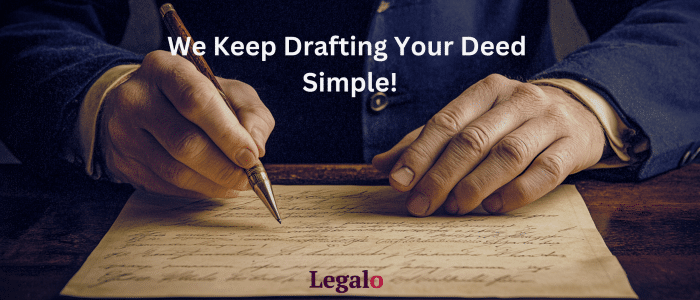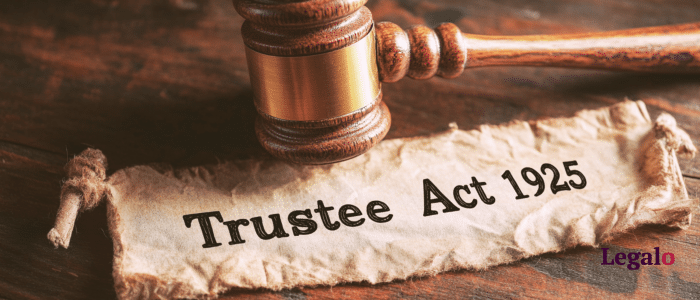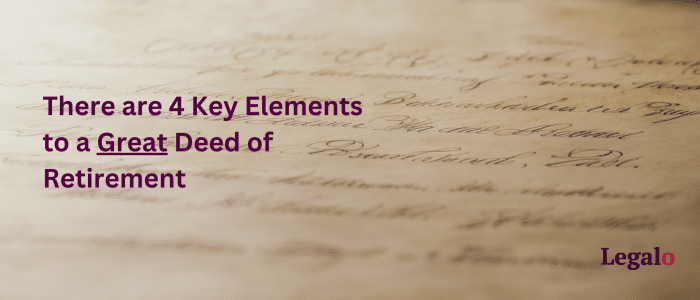Deed of Retirement of Trustee
Use Our Deed of Retirement of Trustee Template to:
- Retire an existing Trustee without hiring a solicitor
- Get peace of mind from using a solicitor-drafted template
- Swiftly complete the removal of the trustee in less than 15 minutes!
- Benefit from our included guide and free customer support helpline
- Take peace of mind with our 100% no quibble money-back guarantee

How Does It Work?
-
1. Download
-
2. Edit
-
3. Print
-
4. Sign
What is a Trustee Deed of Retirement?
A Trustee Deed of Retirement is simply a legal document that a trust uses when a trustee wants to retire or step down from their responsibilities as a trustee.
The deed of retirement operates to record the retirement. It also makes sure that the trust formally releases the departing trustee from their role and the responsibilities that went with the trustee role.
Where the trust involves property, the deed will also confirm the obligation on the retiring trustee to complete any required transfer of the property into the names of the continuing trustees.
You can use Legalo’s deed of retirement of a trustee template with any type of UK trust. Most commonly trusts use it to retire a trustee from a bare trust or a discretionary trust.
This deed only covers the situation where a trustee is retiring from their role. If you want to appoint a new trustee at the same time as removing one, then use this trustee appointment template deed instead.
So, whatever the type of trust arrangement you are dealing with, our deed of retirement template enables you to complete the retirement process simply, swiftly and without needing to hire a solicitor.
“Drafted by David, a co-founder at Legalo, and a practising solicitor in England, our Deed of retirement is a reliable and cost-effective way to complete the trustee retirement”.
When Do You Need a Deed of Retirement?

So, you will need to use a deed of retirement to retire a trustee when an existing trustee is no longer able, or no longer willing, to continue in their trustee role.
Several typical scenarios where a trust would require this document are:
1. The Voluntary Retirement of a Trustee
A trustee rarely remains in their role for life. It is common for a trustee to decide to retire for a range of personal reasons. Most commonly this will be due to age, health or other commitments.
It isn’t necessary for a retiring trustee to provide any reason for their retirement; simply confirmation that they want to retire. The deed of retirement enables them to do so in a formal way.
2. The Non-Voluntary Removal of a Trustee
It may be necessary to retire a trustee because they are long-term unwell, or incapacitated. Occasionally a trust needs the removal of a trustee because of legal disqualification (if they were appointed as a professional trustee), or for misconduct, or by order of the court. In any of these cases, the trust needs a deed of retirement to confirm and record their removal.
3. Changes in Trust Structure
This will apply less frequently, but equally applicable is the situation where the structure of a trust changes. This could be due to the merger of two trusts. In such cases, it may be necessary to retire a trustee to meet the requirements of the trust.
Whatever the reason for the existing trustee’s retiring, a trust needs a deed of removal to meet the legal requirement in section 36 of the Trustees Act 1925, which requires that a there must be confirmation in writing of a trustee’s removal.
The Legal Requirements for Trustee Retirement

In the UK, the retirement of a trustee must meet all legal requirements, including those set out in the Trustee Act 1925.
To meet the legal requirements for a retiring trustee the deed of retirement should cover:
- Consent of Remaining Trustees: Usually, a trustee can only retire if the remaining trustees consent to the retirement (otherwise you may require an application to the court).
- Transfer of Trust Property: The Deed of retirement must set out how the outgoing trustee is to transfer their legal ownership of trust property to the remaining trustees.
- Release from Duties: The Deed of retirement should formally confirm the release of the retiring trustee from their obligations under the trust.
If you do not cover off these steps in the deed of retirement, then it can lead to legal uncertainty and questions over the validity of the trustee’s removal.
The 4 Key Elements of a Deed of Retirement

A well-drafted Trustee Deed of Retirement (like the one available here at Legalo!) will include the following within the document, so that it does what it should:
1. Details of the Parties
It is critical that the deed of retirement sets out the following:
- The Outgoing Trustee: you guessed it – this is the person who is retiring.
- The Remaining Trustees: These are simply the existing trustees who will not be retiring. They are called the ‘Continuing Trustee(s)’ and they will continue to manage the trust. Note that a trust cannot have no trustees and the trust deed may confirm that the trust must at all times have more than one trustee. So check this point before completing your deed.
- Any New Trustees: If the trust is appointing a replacement trustee, you must identify the new trustee in the Deed. (Note that this deed of retirement only covers a retirement situation. If you are appointing a new trustee, use this deed of appointment and retirement version.)
2. Dealing with Trust Property & Update of the Legal Title
A key part of the deed of retirement is to confirm how you will transfer the outgoing trustee’s legal title to any trust property to the continuing trustees. This is critical where the trust holds property (meaning land and/or buildings). You will need to record the transfer at the Land Registry, so get the retiring trustee to sign a TR1 transfer form immediately (assuming the land is already registered land).
If the trust holds cash, then it is usual for the bank to require a copy of the trustee retirement document before they will update the account holder details. You should also transfer any shares that the retiring trustee holds in their name.
3. Release from Duties
The Deed should contain a clause that formally confirms the release of the retiring trustee from his or her duties and obligations under the trust. This is important, particularly to the retiring trustee, as it makes sure that they will not have any liability for the management of the trust after their retirement.
4. Governing Law
To avoid uncertainty the Deed should confirm that it is the laws of England and Wales that apply to the deed and that the English courts have exclusive jurisdiction over any dispute arising related to the deed of retirement. This is particularly important if the trustee is not resident in the UK.
Ok, So Why Use a Trustee Deed of Retirement Template?

Using a Trustee Deed of Retirement template, such as the one available here at Legalo, comes with several advantages. The reality is you’ll have many options available to you when purchasing a template deed of retirement online. I’ll set out below the main reasons why I think you should consider using our template:
1. Our template will certainly save you time
David has carefully drafted the template to make sure that it is in the simplest possible format. We’ve carefully prepared the template so that it requires only minimal editing. We’ve included straightforward guidance notes (also written by David) that will guide you through each step of completing the Deed of Retirement.
2. Our deed is very cost-effective
We all know that hiring a solicitor to draft a bespoke Trustee Deed of Retirement can be expensive. It’s likely to cost you upwards of £500 plus VAT. With our template, you get a solicitor-drafted template deed, so that you can complete your final deed of retirement document simply and also save money.
3. Your deed of retirement will be legally compliant
Our co-founder and solicitor, David, who has extensive experience in trust documents and legal drafting, drafted the template. David’s 29+ years practising as a solicitor means that you get the peace of mind that a highly-experienced UK practising solicitor has prepared the template for you.
4. Clarity and free customer support
We include detailed guidance notes with the template deed, which guide you through each step in the process of producing your trustee deed of retirement from the template.
If you find yourself with any questions, then you can call our free customer support line. You’ll find yourself speaking to David, who will happily guide you through any questions you may have.
A Step by Step Overview to Using Our Template
As I say, full guidance notes are included with the precedent template.
However, below we outline the key steps that you’d need to follow to produce your trustee retirement deed.
Step 1: Purchase and Download the Template
Once you have purchased the template from us, here at Legalo, you’ll be able to download it to your computer, tablet or phone for editing. Our template deed is downloadable in Microsoft Word format, so make sure you have appropriate word-processing software.
Step 2: Fill in the Editable Details
David has clearly highlighted within the template the sections that you will need to edit. These are:
- Names of the Continuing Trustees: Add the names and addresses of the trustees that are not retiring.
- The Name of Retiring Trustee: You’ll need to add the name and address of the trustee who is retiring.
- The Trust Name: Trusts are generally given a name which will be in the trust deed that created the trust. If the trust was created by a will, then it will often be the name of the deceased and the words ‘Will Trust’.
- Trust Property Transfer: Set out the property that will be transferring. This is most likely to be cash at bank, shares, or physical property.
Step 3: Signatures and Execution
Once you have added the required information to the template deed, then it is ready for signing. All of the parties to the deed must sign it and an independent person must witness the signatures. The completed deed of retirement can be signed in ink or digitally, using software such as Adobe SIgn, DocuSign or other digital signing solutions. This process of signing and witnessing the deed is called ‘execution’ of the deed.
Step 5: Retain the Executed Deed
Make sure that, once signed, you store the signed deed of retirement safely. Ideally, a copy of it should be provided to the continuing trustees and the original retained by the retiring trustee.
Common Mistakes to Avoid
Please call our free customer support line if you have any questions when completing the template deed. Here are the two most common mistakes to help you avoid them yourself.
1. Incomplete Information
It is critical that the parties section includes all of the trustees. So make sure you add the trustees that are continuing as well as the retiring trustee. A common mistake is not to include all of the trustees.
2. Missing Signatures
One we see all too often across legal documents is overlooking getting the document signed by all the parties. In this case each party must sign and their signature must be witnessed, and the witness’s details included in the spaces provided for this in the template.
Legal Considerations and FAQs

I’ll cover off below some of the more common questions that I see asked about a deed of retirement of a trustee.
1. Is the Deed of Retirement Legally Binding?
Yes, as soon as the deed of retirement of a trustee is signed and witnessed, it becomes legally binding. At that point, the outgoing trustee is released from all of their responsibilities and obligations relating to the trust.
2. Do I Need to Appoint a New Trustee?
Unless the number of trustees falls below the minimum required by the trust deed or applicable law, provided that the trust has at least one remaining trustee, then, no, you do not need to appoint a new trustee. If the retirement would result in there being no trustees, then you would have to appoint a new trustee at the same time as retiring the outgoing trustee.
3. Do you need a deed to remove a trustee?
Section 36 of The Trustees Act 1925 requires that you must confirm the removal or retirement of a trustee in writing. If a trustee seeks to retire without a deed of retirement, or other written document, then:
- their retirement will be ineffective; and
- they will remain responsible to the trust as a continuing trustee.
4. Do I Need to File the Deed with HMRC or other official bodies?
Keep in mind that you must notify HMRC of any change in the trustees. This must be done within 90 days of the change. It can be done here on the HMRC website. If the trust owns land or property, then the change in trustees should be notified to the Land Registry. To do so, file a TR1 form.
Why Use a Trustee Deed of Retirement Template from Legalo?
There are many good reasons to buy your trustee deed of retirement template from us here at Legalo, instead of one of the other online retailers:
- Expertly drafted: Unlike most of the sites online selling template deeds of retirement, this website is owned and operated by two practising UK solicitors.
- Tailored for UK law: With our extensive knowledge of UK trust law and experience in this sector this template deed has been carefully drafted to meet all the requirements of UK law.
- Instant access: Once purchased, you can immediately download the template and start to draft your deed of retirement. It is likely to take you less than 15 minutes to complete.
- Free customer support: Unlike many online providers, we provide a customer support line that you can call during normal office hours and speak to David, who will answer any technical questions that you may have about the document.
- Money-back guarantee: In the unlikely event that you are not satisfied with your purchase, we offer our Legalo no quibbles, money-back guarantee.
Purchase Your Deed of Retirement Template Today
If you need to retire a trustee from a trust and want to do so in a simple and very cost-effective way, then:
- buy your template deed of retirement from us; and
- have your completed deed ready within 15 minutes.
If you have any query, or uncertainties that you’d like to discuss before you buy our template precedent deed, then please do contact us.
Telephone is the quickest way, but if you prefer to use our contact form we will generally respond the same day.

